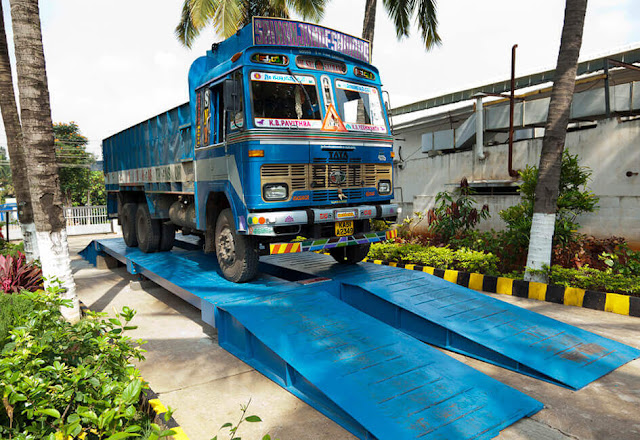Different Types of Weighbridges Explained
Weighbridges, as the
name suggests, are specifically constructed structures designed to measure the
weight of heavy loading vehicles. Any business with logistics requirements has
a need for a weighbridge. There are different types of weighbridges available,
each suitable for different requirements. Let’s take a look at all the types of
weighbridges, with their advantages and disadvantages.
There are three major
types of weighbridges:
-
Above ground or
pitless weighbridge
-
Semi-pit weighbridge
- In-ground weighbridge or pit weighbridge
Then there are some variations of these weighbridges which we’ll describe later. Let’s understand what makes these three weighbridges different and why.
Above-ground or pitless weighbridges
In places where there is no lack of space, the pitless weighbridge is preferred. Pitless refers to the lack of a pit or a trench needed to construct. All the weighing machinery and construction can be done on the ground. The reason why this weighbridge is preferred is cost. Pitless weighbridges are very cost-friendly and since these are electronic weighbridges, they are very efficient as well.
The disadvantage of
this weighbridge is that it needs a lot of space for operation. Since all the
machinery is on the ground, ramps are needed for the vehicles to mount on the
weighbridge. The entry and exit ramps have to be at least 5 meters in length
with a meter of open space on both sides. So if lack of space is not a factor,
then this is the weighbridge to go for.
Pit weighbridges
Pit weighbridges are
constructed inside pits or trenches. The main advantage of this weighbridge is
that it requires the least amount of space. Since all the machinery is under
the ground, there is no requirement of making ramps. Pit weighbridges are
preferred in places with space restrictions.
The disadvantage of
this weighbridge is that it is very expensive. Since a lot of excavation needs
to be done, along with other supporting constructions such as site preparation,
reinforcement, etc, pit weighbridges can get quite expensive. The maintenance
also requires special intervention.
Semi-pit weighbridge
These weighbridges are
neither built on the ground nor inside, but somewhere in the middle. What this
type of weighbridge tries to provide is the benefits of both the pit and
pitless weighbridge. This is preferable in sites where space is constricted,
but not too much. Ramps are not required for this type of weighbridge.
But some excavation
and construction are required. Semi-pit weighbridges require retaining walls at
least 1 meter away from the weighbridge. But the cost of construction is lower
than pit weighbridge.
Apart from these three
main weighbridges, there are some variations or modifications. There are:
-
Customized pitless or
pit weighbridges
-
Multi-deck
weighbridges
-
Portable weighbridges
Customizedweighbridges are specially designed to suit the specific requirements of
certain sites or spaces. The semi-pit weighbridge is the most customizable
weighbridge out of the three.
Multi-deck weighbridges
are designed to weigh multiple vehicles of different weights at the same time.
Portable truck scales are a variation of the pitless weighbridge constructed in a way to be used only for around 2 years. Concrete weighbridge manufacturers use slabs of concrete and other material to create the deck for this weighbridge.
This was all about the
different types of weighbridges, from concrete pitless weighbridges to steel weighbridges.


Comments
Post a Comment